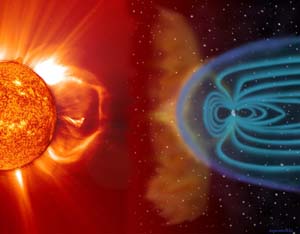 Illustration of a blast of solar wind impacting
Illustration of a blast of solar wind impacting
Earth's protective magnetic field. Credit: NASABreathe in, exhale. Feel the air in your mouth, windpipe, and lungs. That's a sample of Earth's atmosphere: the thin layer of gases enveloping our planet.
Did you know that the Sun also has an atmosphere, and that the Earth is inside it? In fact, the Sun's envelope of gases extends well beyond the orbit of Pluto, out to the regions of the solar system where the 3-decade-old Voyager spacecraft are only now reaching.
"Space weather" refers to the conditions in space caused by the outflow of electrically charged gases (plasma) coming from the Sun—what we call the "solar wind." The term "space weather" may conjure images of cosmic tornadoes, astral lightning bursts, and some Star Trek version of a galactic hurricane-- but actual space weather is nothing so Earthly and familiar.
First of all, the "air" in space is nothing like the atmosphere we draw our breath from. Earth air, at the surface, is made of nitrogen, oxygen, argon, carbon dioxide, water vapor, and other trace elements, and is relatively dense. "Space air" is mostly hydrogen-- ionized hydrogen at that (meaning stripped of its electrons and so electrically charged; the separated electrons are also blowing along in the solar wind).
Second, the gases of the solar wind are extremely rarified. Despite the talk of a solar atmosphere, solar wind, and space weather, space within the solar system is still almost a complete vacuum. At Earth's distance from the Sun, the average density of the solar wind is somewhere between 6 and 9 atoms (mostly hydrogen) per cubic centimeter. If you spread out the gas contained in an ordinary party balloon to this same thinness, it would fill a volume of space over 10 miles across!
